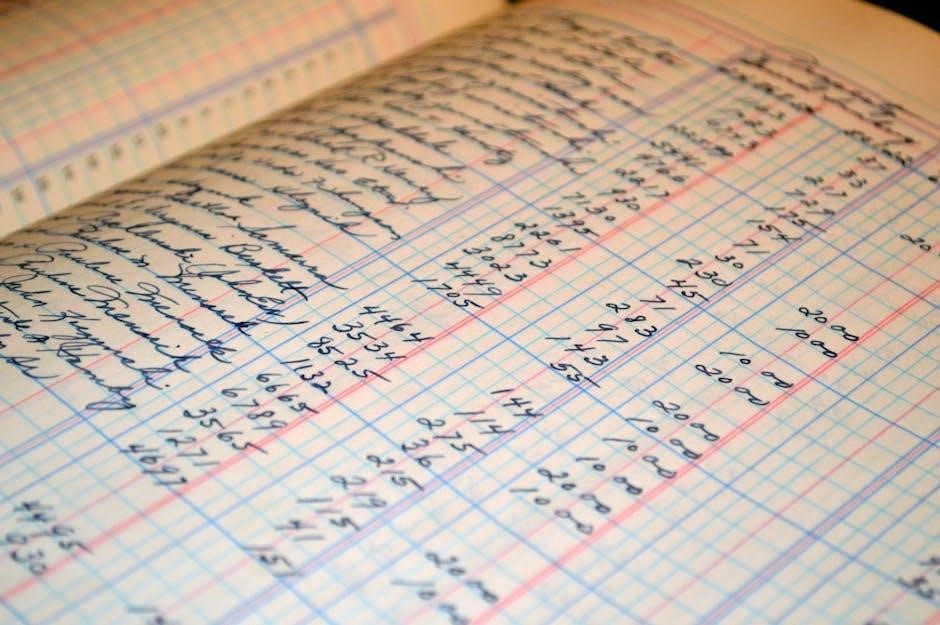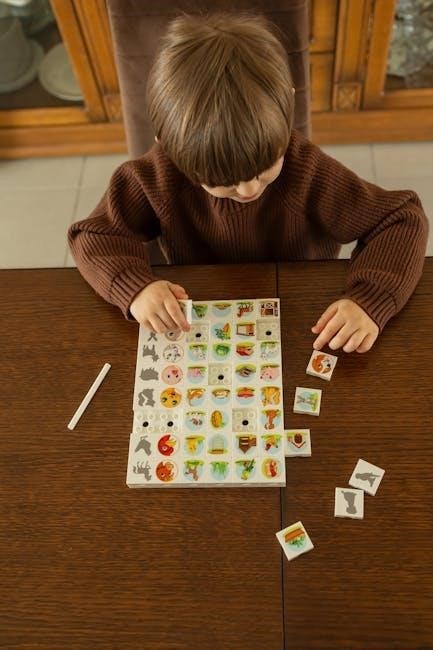A sticker chart is a visual tool where children earn stickers for positive behavior or completed tasks. It helps track progress, encouraging motivation and accountability in a fun, engaging way.
1.1 Definition and Purpose of Sticker Charts
A sticker chart is a visual tool designed to track and reinforce positive behavior or task completion. It consists of a grid or list where children earn stickers for achieving specific goals, such as completing chores, demonstrating good behavior, or meeting learning milestones. The primary purpose of a sticker chart is to provide immediate, tangible feedback and motivation for children. By seeing their progress visually, kids develop a sense of accomplishment and accountability. Sticker charts are customizable, allowing parents or educators to tailor them to individual needs, whether for daily routines, behavior management, or educational goals. They are simple, cost-effective, and engaging, making them a popular choice for encouraging responsibility and self-discipline in children. Over time, sticker charts help build habits and a positive mindset, fostering long-term personal growth and development.
1.2 Importance of Sticker Charts for Behavior Management
Sticker charts are a powerful tool for behavior management, offering a structured and visual way to guide children toward positive actions. They help children understand expectations clearly and see the consequences of their behavior. By rewarding good behavior with stickers, parents and educators reinforce desired habits, encouraging consistency and repetition. This method is particularly effective for young children, as it provides immediate feedback and a sense of achievement. Sticker charts also promote self-regulation, teaching kids to take responsibility for their actions. Over time, this can lead to improved self-discipline and a reduction in negative behaviors. Additionally, sticker charts foster a positive environment, focusing on encouragement rather than punishment, which is essential for healthy emotional and social development. Their simplicity and adaptability make them a versatile solution for various behavior management needs, ensuring they remain a valuable resource for parents and educators alike.

Benefits of Using Sticker Charts
Sticker charts offer a fun, visual way to encourage positive behavior, track progress, and motivate children to complete tasks. They foster responsibility, accountability, and self-esteem while providing clear goals and rewards.
2.1 Encouraging Positive Behavior in Children
Sticker charts are an effective tool for encouraging positive behavior in children by providing immediate visual feedback and reinforcement. By earning stickers for actions like sharing, kindness, or completing homework, kids develop a sense of accomplishment and pride. This method works well for younger children, as it uses a tangible reward system that is easy to understand; The charts also help parents and educators consistently reinforce good behavior, making it more likely to become a habit. Over time, this positive reinforcement can lead to lasting behavioral changes, as children learn to associate good actions with rewards. The use of colorful stickers or themes adds an element of fun, further motivating children to exhibit positive behavior regularly.
2.2 Teaching Responsibility and Accountability
Sticker charts are an excellent way to teach children responsibility and accountability by breaking tasks into manageable steps. Each sticker represents a completed task or achieved milestone, helping kids understand the importance of follow-through. The visual nature of the chart allows children to see their progress, fostering a sense of ownership over their actions. By earning stickers, they learn to associate effort with results, building a foundation for accountability. This method is particularly effective for younger children, as it provides clear expectations and immediate feedback. Over time, sticker charts help children develop self-discipline and a routine for completing tasks, making responsibility feel achievable and rewarding. This approach not only teaches accountability but also prepares kids for more complex responsibilities as they grow.
2.3 Motivating Kids to Complete Chores and Tasks

Sticker charts are a powerful tool for motivating children to complete chores and tasks. By providing visual rewards, they create a sense of accomplishment and excitement. Each sticker earned serves as a tangible reminder of progress, encouraging kids to stay on track. The charts help break tasks into smaller, manageable steps, making the process less overwhelming. Parents can customize charts to suit different age groups and abilities, ensuring that goals are realistic and achievable. The immediate feedback from earning a sticker fosters a positive association with completing tasks. Over time, this method helps build consistency and a strong work ethic in children. The variety of printable PDF templates available online makes it easy to find a design that resonates with a child’s interests, further enhancing motivation and engagement.

How to Create a Sticker Chart
Creating a sticker chart involves designing a grid with tasks or behaviors listed. Use printable PDF templates or draw your own. Add columns for days or tasks and include a section for rewards. Customize with colors or themes to make it engaging for children. Ensure it’s simple and clear, making it easy for kids to track their progress visually. This visual tool helps children stay motivated and focused on their goals. Adding stickers or stamps provides immediate feedback, reinforcing positive actions. The chart can be adjusted based on age and specific needs, making it versatile for various purposes. Use free printable PDF templates to save time and effort. Make it fun by allowing children to choose their preferred design or theme. This hands-on approach encourages participation and accountability. Regularly updating the chart helps maintain enthusiasm and commitment to achieving set goals. Celebrate milestones to reinforce the value of effort and perseverance. Adjustments can be made as needed to keep the chart relevant and effective. The chart serves as a helpful reminder of daily tasks and responsibilities. Track progress consistently to help children develop a routine. The use of stickers or stamps adds an element of excitement, making the process enjoyable. This method fosters a sense of accomplishment and pride in completing tasks. Encourage children to take ownership of their chart, promoting independence and self-management. The chart can be displayed in a visible location to serve as a constant reminder of goals. Use stickers or stamps that align with the chart’s theme for a cohesive look. The chart’s design should be age-appropriate and engaging to capture the child’s interest. Provide clear instructions on how to use the chart to ensure understanding. The chart’s flexibility allows it to be adapted for different needs and preferences. Use high-quality printable templates to ensure the chart looks professional and appealing. The chart’s effectiveness lies in its ability to provide clear, immediate feedback. Use it consistently to help children develop good habits and a strong work ethic. The chart’s simplicity makes it easy to integrate into daily routines without causing overwhelming. The chart’s customization options ensure it can be tailored to fit individual needs and preferences. The chart’s portability allows it to be used in various settings, such as home or school. The chart’s adaptability makes it suitable for children of different ages and developmental stages. The chart’s effectiveness is enhanced when combined with verbal praise and encouragement. The chart’s success lies in its ability to make task completion feel rewarding and satisfying. Use the chart as a positive reinforcement tool to encourage desired behaviors. The chart’s impact is maximized when it is used consistently and fairly. The chart’s design should be visually appealing to capture the child’s attention. The chart’s use of bright colors and engaging themes can increase motivation. The chart’s ability to track progress over time helps children see their improvements. The chart’s flexibility allows it to be used for a wide range of tasks and behaviors. The chart’s effectiveness is supported by the immediate reward system it provides. The chart’s simplicity makes it easy to understand and use for children. The chart’s customization options ensure it can be tailored to fit specific needs. The chart’s use of stickers or stamps adds an element of fun and excitement. The chart’s ability to be printed for free makes it accessible to everyone. The chart’s design should be clear and easy to read to avoid confusion. The chart’s effectiveness is enhanced when it is personalized for the child. The chart’s use of visual rewards helps children stay motivated and engaged. The chart’s flexibility allows it to be used for both short-term and long-term goals. The chart’s simplicity makes it easy to incorporate into daily life without hassle. The chart’s customization options ensure it can grow with the child’s changing needs. The chart’s effectiveness is supported by the positive reinforcement it provides. The chart’s use of stickers or stamps creates a sense of accomplishment. The chart’s ability to be adapted for different purposes makes it versatile. The chart’s design should be engaging to keep the child’s interest over time. The chart’s effectiveness lies in its ability to provide immediate feedback. The chart’s use of visual rewards helps children understand their progress. The chart’s flexibility allows it to be used in various settings and situations. The chart’s customization options ensure it can be tailored to fit individual preferences. The chart’s effectiveness is enhanced when it is used consistently. The chart’s design should be appealing to capture the child’s attention. The chart’s use of bright colors and themes increases motivation. The chart’s ability to track progress over time helps children see improvements. The chart’s flexibility allows it to be used for a wide range of tasks. The chart’s effectiveness is supported by the immediate reward system. The chart’s simplicity makes it easy to understand and use. The chart’s customization options ensure it can be tailored to fit specific needs. The chart’s use of stickers or stamps adds fun and excitement. The chart’s ability to be printed for free makes it accessible. The chart’s design should be clear and easy to read. The chart’s effectiveness is enhanced when personalized. The chart’s use of visual rewards keeps children motivated. The chart’s flexibility allows it to be used for various goals. The chart’s simplicity makes it easy to incorporate into daily life. The chart’s customization options ensure it can grow with the child. The chart’s effectiveness is supported by positive reinforcement. The chart’s use of stickers creates a sense of accomplishment. The chart’s ability to be adapted makes it versatile. The chart’s design should be engaging to maintain interest. The chart’s effectiveness lies in providing immediate feedback. The chart’s use of visual rewards helps children understand progress. The chart’s flexibility allows it to be used in various settings. The chart’s customization options ensure it can be tailored. The chart’s effectiveness is enhanced with consistent use. The chart’s design should be appealing to capture attention. The chart’s use of colors and themes increases motivation. The chart’s ability to track progress shows improvements. The chart’s flexibility allows it to be used widely. The chart’s effectiveness is supported by rewards. The chart’s simplicity makes it easy to use. The chart’s customization options fit individual needs. The chart’s use of stickers adds excitement. The chart’s free availability makes it accessible. The chart’s design should be clear. The chart’s effectiveness is enhanced when personalized. The chart’s use of rewards keeps children motivated. The chart’s flexibility allows varied use. The chart’s simplicity makes it easy. The chart’s customization grows with the child. The chart’s effectiveness is supported. The chart’s use of stickers creates accomplishment. The chart’s adaptability makes it versatile. The chart’s design maintains interest. The chart’s effectiveness provides feedback. The chart’s use of rewards helps progress. The chart’s flexibility allows settings. The chart’s customization tailors. The chart’s effectiveness enhances. The chart’s design captures attention. The chart’s use of themes motivates. The chart’s ability shows progress. The chart’s flexibility allows tasks. The chart’s effectiveness rewards. The chart’s simplicity makes it easy; The chart’s customization fits needs. The chart’s use of stickers excites. The chart’s availability is free. The chart’s design is clear. The chart’s effectiveness is enhanced. The chart’s use of rewards motivates. The chart’s flexibility allows goals. The chart’s simplicity is easy. The chart’s customization grows. The chart’s effectiveness supports. The chart’s use of stickers accomplishes. The chart’s adaptability is versatile. The chart’s design interests. The chart’s effectiveness feeds back. The chart’s use of rewards progresses. The chart’s flexibility allows settings. The chart’s customization tailors. The chart’s effectiveness enhances. The chart’s design captures attention. The chart’s use of themes motivates. The chart’s ability shows progress. The chart’s flexibility allows tasks. The chart’s effectiveness rewards. The chart’s simplicity is easy. The chart’s customization fits needs. The chart’s use of stickers excites. The chart’s availability is free. The chart’s design is clear. The chart’s effectiveness is enhanced. The chart’s use of rewards motivates. The chart’s flexibility allows goals. The chart’s simplicity is easy. The chart’s customization grows. The chart’s effectiveness supports. The chart’s use of stickers accomplishes. The chart’s adaptability is versatile. The chart’s design interests. The chart’s effectiveness feeds back. The chart’s use of rewards progresses. The chart’s flexibility allows settings. The chart’s customization tailors. The chart’s effectiveness enhances. The chart’s design captures attention. The chart’s use of themes motivates. The chart’s ability shows progress. The chart’s flexibility allows tasks. The chart’s effectiveness rewards. The chart’s simplicity is easy. The chart’s customization fits needs. The chart’s use of stickers excites. The chart’s availability is free. The chart’s design is clear. The chart’s effectiveness is enhanced. The chart
3.1 Step-by-Step Guide to Designing a Sticker Chart
Creating a sticker chart begins with selecting a printable PDF template or designing your own. Start by defining the chart’s purpose, such as tracking chores, behavior, or learning goals. Next, list the tasks or behaviors along one side and days of the week or progress markers along the top. Divide the chart into rows and columns to create a grid. Add a section for rewards at the end to motivate completion. Customize the design by choosing colors, themes, or illustrations to make it visually appealing. Print the chart on high-quality paper and laminate it for durability. Finally, explain the chart to the child, demonstrating how stickers or stamps will be added as they complete tasks. This step-by-step approach ensures the chart is clear, engaging, and effective for encouraging positive behavior or task completion. Regular updates and celebrations of milestones will keep the child motivated and invested in their progress.
3.2 Choosing the Right Template for Your Needs
Selecting the ideal sticker chart template depends on your specific goals and preferences. With numerous free printable PDF options available online, you can find designs tailored to chores, behavior management, or educational milestones. Opt for themes that align with your child’s interests, such as space, animals, or colorful patterns, to ensure engagement. Consider the age and needs of the child when choosing simplicity or complexity. Many templates allow customization, enabling you to add personal touches or modify tasks. Websites like Pinterest and specialized educational platforms offer a wide range of templates, ensuring there’s one to suit every scenario. By picking a template that matches your objectives and the child’s personality, you create a tool that is both functional and enjoyable. This step is crucial for maximizing the effectiveness of the sticker chart in encouraging positive habits and achievements.
3.3 Adding Rewards and Incentives to the Chart
Enhance the effectiveness of your sticker chart by incorporating rewards and incentives. These can be small prizes, privileges, or special activities, such as extra playtime or a favorite meal. Align the rewards with the child’s interests to boost motivation. For example, a completed chart might offer a trip to the park or a new toy. Some printable PDF templates include spaces for listing rewards, making it easy to set clear goals. Rotate incentives periodically to maintain excitement and prevent boredom. Ensure rewards are achievable and proportional to the effort required. This system fosters a sense of accomplishment and encourages consistent progress. By integrating rewards, you create a positive reinforcement loop that makes the sticker chart a powerful tool for behavior management and task completion. This approach keeps children engaged and eager to earn their next sticker.

Popular Types of Sticker Charts

Popular sticker charts include behavior, chore, and educational designs. They cater to specific goals like good behavior, task completion, or learning milestones, offering customization for various needs and preferences.
4.1 Behavior Sticker Charts for Kids
Behavior sticker charts are a popular tool to encourage positive actions in children. These charts allow kids to earn stickers for good behavior, such as sharing, using manners, or completing tasks. Available as free printable PDFs, they are easy to download and customize. Many designs feature fun themes like animals or space, making them engaging for young minds. Parents and educators can use these charts to track progress and reinforce desired behaviors. By offering visual rewards, they help children develop self-regulation skills and a sense of accomplishment. With options to personalize colors and themes, behavior sticker charts are versatile and effective for promoting positive habits in kids of all ages.
4.2 Chore Sticker Charts for Daily Tasks
Chore sticker charts are a practical way to encourage children to complete daily tasks. These charts help kids stay organized by breaking down chores into manageable steps. Available as free printable PDFs, they often feature space for daily or weekly tasks, with stickers awarded upon completion. Themes like colorful grids or fun illustrations make them appealing to children. Parents can customize the charts to suit their child’s responsibilities, such as cleaning their room or setting the table. Earning stickers motivates kids to take ownership of their tasks, teaching them responsibility and accountability; Over time, these charts help build consistent habits, making chores a positive and rewarding experience for children of all ages.
4.3 Educational Sticker Charts for Learning Goals
Educational sticker charts are a fun and interactive way to support children in achieving learning milestones. These charts are designed to help kids track progress in subjects like reading, math, or language skills. They often feature themes related to academics, such as books, numbers, or science symbols, making them engaging for students. Teachers and parents can use these charts to reward efforts like completing homework, mastering new concepts, or participating in class. Many free printable PDF templates are available online, offering customizable options to suit individual learning goals. By earning stickers for achievements, children build confidence and develop a positive attitude toward learning. These charts are particularly effective for young students, as they provide a visual and tangible way to celebrate academic success and stay motivated. They’re a great tool for fostering a love for learning in a structured and rewarding manner.

Customizing Your Sticker Chart
Customize your sticker chart with vibrant colors, themes, and stickers to make it visually appealing. Personalize it to match your child’s interests or add themed elements like animals or space for fun. Use stamps or additional rewards to enhance engagement and motivation. Many free printable PDF templates offer flexibility, allowing you to tailor the design to suit individual preferences and goals. This personal touch ensures the chart feels unique and exciting, encouraging consistent use and progress tracking. By adapting the chart to your child’s personality, you create a tool that fosters enthusiasm and participation in achieving their objectives. Customize today and watch your child thrive with a chart that’s all their own!
5.1 Personalizing Colors and Themes
Personalizing colors and themes on your sticker chart adds a fun and engaging dimension. Choose vibrant colors that appeal to your child, such as bright pinks, blues, or yellows, to make the chart visually appealing. Themes like space, animals, or superheroes can align with your child’s interests, making the chart more exciting. Many free printable PDF templates offer themed designs, allowing you to select one that matches your child’s personality. For example, a space-themed chart might feature planets or rockets, while an animal-themed chart could include cute illustrations of wildlife. Personalizing the design ensures the chart feels tailored to your child, increasing their enthusiasm and participation. Additionally, you can customize the color scheme to match your home decor or your child’s favorite hues, creating a cohesive and inviting tool for behavior management.
5.2 Adding Stickers or Stamps for Visual Appeal
Adding stickers or stamps to your chart enhances its visual appeal and makes it more engaging for children. Stickers come in various shapes, sizes, and themes, allowing you to match them to your child’s interests. For example, animal-themed stickers can complement an animal-themed chart, while star or smiley-face stickers can reward positive behavior. Stamps are another great option, offering a tactile experience for kids. Many free printable PDF templates include spaces specifically designed for stickers or stamps, making it easy to incorporate them. The act of placing a sticker or stamp on the chart provides a sense of accomplishment and motivates children to continue earning more. This interactive element makes the process fun and rewarding, encouraging consistent effort and positive behavior. Over time, the colorful stickers or stamps create a visual record of progress, reinforcing the child’s sense of achievement.
5.3 Creating a Themed Sticker Chart (e.g., Space, Animals)
Creating a themed sticker chart adds an extra layer of excitement and personalization. Themes like outer space or animals can spark your child’s imagination and make the process more engaging; For example, a space-themed chart might feature planets, rockets, or stars, while an animal-themed chart could include illustrations of wildlife or pets. Many free printable PDF templates offer a variety of themes, allowing you to choose one that aligns with your child’s interests. Customizing the chart with themed stickers or stamps further enhances the experience. This not only makes the chart visually appealing but also helps your child connect with the theme, increasing their motivation. Themed charts are particularly effective for younger children, as they combine fun and learning, making behavior management and task completion a enjoyable activity. This approach fosters creativity while maintaining focus on the chart’s purpose.

Implementing a Sticker Chart
Start by setting clear goals and explaining the process to your child. Use a printable PDF chart, mark progress with stickers, and celebrate milestones consistently for motivation and success.
6.1 Setting Clear Goals and Expectations

Setting clear goals and expectations is essential for the success of a sticker chart. Begin by identifying specific behaviors or tasks you want to encourage, such as completing chores or demonstrating kindness. Use a printable PDF sticker chart to create a structured format for tracking progress. Explain the rules clearly to your child, ensuring they understand what actions will earn stickers and how many stickers are needed for a reward. Involve your child in the process, allowing them to help choose the goals or design of the chart. This fosters a sense of ownership and motivation. Make sure the goals are achievable but challenging enough to encourage effort. Regularly review and adjust the expectations as needed to maintain engagement and ensure the chart remains effective. Consistency is key to helping your child stay focused and committed to their objectives.
6.2 Tracking Progress and Celebrating Milestones
Tracking progress on a sticker chart helps children visualize their achievements and stay motivated. Each sticker represents a step closer to their goal, fostering a sense of accomplishment. Celebrate milestones, such as filling a row or earning a predetermined number of stickers, with praise or small rewards. This reinforces positive behavior and encourages continued effort. Use a printable PDF sticker chart to easily monitor progress and identify patterns in behavior or task completion. Be sure to acknowledge even small successes, as this builds confidence and reinforces the connection between effort and results. Over time, this process helps children develop self-esteem and a growth mindset, understanding that consistent effort leads to meaningful outcomes. Regular celebration of milestones ensures the sticker chart remains an effective and engaging tool for behavior management and skill development.
6.3 Adjusting the Chart for Different Ages and Needs
Sticker charts can be tailored to suit different ages and needs, ensuring they remain effective for various developmental stages. For younger children, use simple, colorful designs with clear goals, such as a printable PDF sticker chart featuring fun themes like animals or space. Older kids may benefit from more complex charts with larger goals or multiple categories. Customize the chart by adding extra rows or columns for specific behaviors or tasks. Incorporate visual aids like stickers or stamps to make it engaging. Additionally, consider individual needs by adjusting the number of stickers required for rewards or introducing bonus stickers for consistent progress. This flexibility ensures the chart remains relevant and motivating. Use free printable templates to experiment with different designs and adapt them as needed for different ages or abilities. This customization helps maintain engagement and effectiveness.

Free Printable Sticker Chart Resources
Discover a wide selection of free printable PDF sticker charts online. These customizable templates are perfect for behavior management, chores, and educational goals, offering a fun way to track progress.
7.1 Websites Offering Free PDF Downloads
Several websites provide free printable sticker chart templates in PDF format. Popular options include Pinterest, Canva, and Printablee, offering a variety of designs and themes. Many sites allow users to download templates instantly, while others may require signing up for free accounts. Websites like Teachers Pay Teachers and Etsy offer customizable charts, catering to specific needs such as behavior management or chore tracking. Some platforms, such as Scribd, provide a wide range of free PDF resources, including sticker charts for potty training, chores, and educational goals. These websites are user-friendly, making it easy to find and download the perfect chart for your needs. With just a click, you can access high-quality, printable PDFs to help motivate and organize children effectively. These resources are ideal for parents, teachers, and caregivers seeking affordable and convenient tools for behavior management. The availability of free PDF downloads ensures accessibility for everyone.
7;2 Tips for Finding the Best Templates Online
To find the best sticker chart templates online, start by using specific keywords like “printable,” “PDF,” and “free” to narrow your search. Visit popular platforms like Pinterest, Canva, and Teachers Pay Teachers, which offer a wide variety of designs. Always read reviews or descriptions to ensure the template meets your needs. Look for customizable options to tailor the chart to your child’s preferences or goals. Consider themes like animals, space, or seasonal designs to make the chart more engaging. Additionally, check for templates that include editable fields or stickers for added flexibility. Many websites also offer bundles or sets, which can provide multiple chart options in one download. By exploring these tips, you can easily find high-quality, printable PDF sticker charts that suit your specific requirements. This ensures a fun and effective tool for behavior management or task tracking.
7.3 Printable Sticker Charts for Specific Purposes (e.g., Potty Training)
Sticker charts can be tailored for specific purposes, such as potty training, chore completion, or educational goals. For potty training, charts often feature fun themes like unicorns or animals to motivate toddlers. Chore-specific charts help kids track daily tasks, while educational charts focus on learning milestones. Many templates are designed for particular age groups or needs, ensuring relevance and engagement. Themes like space, princesses, or superheroes are popular for kids. These charts are easily downloadable as PDFs and can be printed at home. Websites like Pinterest and Canva offer a wide range of customizable options. By selecting charts that align with specific goals, parents and educators can create targeted tools to encourage progress and celebrate achievements. This makes sticker charts versatile and effective for various developmental stages and objectives.